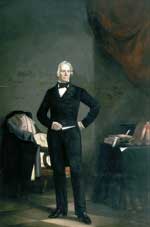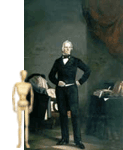VAM galleries including this work:
The Kentucky Historical Society | Kentucky Past and Present || VAM Home
William Frye (Austrian American, 1819-1872)
HENRY CLAY, c. 1865
Oil on canvas; 126" X 84"
Donated by the State Board of Control, 1909.5
Courtesy Kentucky Historical Society
Henry Clay was a prominent early Kentuckian and an important figure in the national political arena of the early 19th century. He was born in Virginia in 1777. In 1796 he moved to Lexington, where he soon became a successful lawyer and gentleman farmer. He was elected to the United States Senate in 1806 and served under several presidents. In 1824 he was appointed Secretary of State under John Quincy Adams. He also served 14 years as the Speaker of the House.
Clay was devoted to the Union and became known as the “Great Compromiser” for his efforts in negotiating agreements such as the Missouri Compromise. He ran for president, unsuccessfully, as the Whig candidate in 1832 and 1844. Clay returned to Washington, D.C. in December 1851, but his health was deteriorating, and he made only one appearance in the Senate before his death on June 29, 1852. After lying in state in the U.S. Capitol—the first person to be so honored—he was buried in the Lexington Cemetery.
About the Artist
During its 1864-1865 session, the Kentucky state legislature made an appropriation for a portrait of Henry Clay to be placed in the Senate Chamber. According to one story, the committee in charge of the portrait invited artists to compete for the work. Only one artist responded—George Wilhelm (William) Frye. Born at Reslau on the border of Bohemia, Frye was reared in Vienna and received his art education at Prague in Bohemia. At the time of the commission he was living in Huntsville, Alabama.
Classroom Ideas
Discussion: What does this portrait tell you about Henry Clay? Does it give you a sense of what type of person he might have been? Examine and discuss the facial expression, pose, clothing, props, and artistic elements. Compare this portrait to others of Clay and to his portrayals by 19th-century political cartoonists (see the links below). Do you think this is a good composition? What color do you notice most?
Activity: Plan and create portraits of historic or contemporary political figures in a chosen style, such as a formal portrait or political caricature.
Links
For a summary of Clay’s life and political career, read the Henry Clay article in the Kentucky Encyclopedia (subscription required for online version).
[www.kyenc.org/entry/c/CLAYH01.html]
Political cartoons relating to Henry Clay and his times can be found at the Harper’s Weekly HarpWeek site.
[www.harpweek.com]
A portrait of Henry Clay by Allyn Cox hangs in the U.S. Senate.
[www.senate.gov/artandhistory/art/artifact/Painting_32_00007.htm]
Read Abraham Lincoln’s eulogy of Clay at Abraham Lincoln Online.
[showcase.netins.net/web/creative/lincoln/speeches/clay.htm]
View other examples of portraits at the Smithsonian Institution’s National Portrait Gallery.
[www.npg.si.edu]


